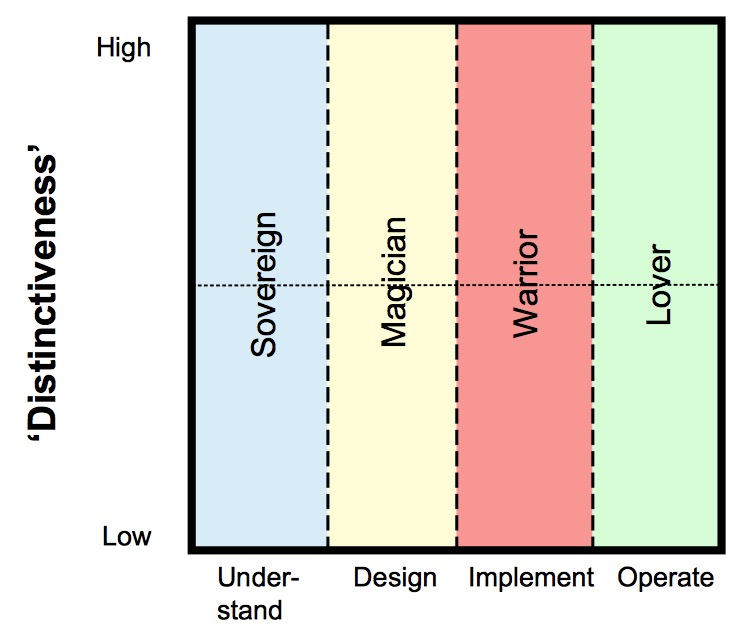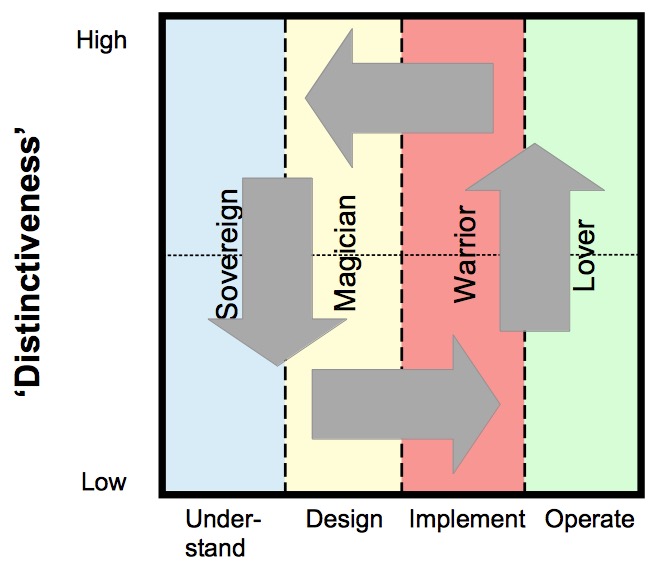Part of Jungian psychology includes the idea that we interpret the world in terms of archetypes.
There are several of these, but the work of two Jungian analysts, Robert Moore and Douglas Gillette, has distilled them down to just four.
By combining the two essential qualities of people’s psychology as either active or passive and feminine or masculine, they identified four essential Jungian archetypes:
- Sovereign
- Warrior
- Magician
- Lover
There isn’t space to go into detail here, but other archetypes can be seen as combinations of these fundamentals. And all four archetypes exist to a greater or lesser degree in everyone.
The Sovereign represents the ‘passive masculine’. If you think of a fairy story I am sure you can imagine the archetype of a strong, wise king. This is the passive masculine energy of the Sovereign, and it is important to emphasise that it can just as easily be held by a woman — a strong, wise queen — as by a king. Both sexes can embody the archetype of the Sovereign: who is someone who is good at understanding the situation and knows what needs to be done to take best care of the kingdom.
Equally I am sure you can imagine the archetype of the honourable Warrior who takes just action on behalf of that Sovereign. Who gets done the things that need to get done. This represents the ‘active masculine’. And again, this can equally be embodied by women as by men. Think of the Suffragettes who fought so that women could vote, and the women who multitask and get everything done. This is Warrior energy.
Then there are the ‘feminine’ archetypes. The ‘active feminine’ is the creativity of the Magician. This is someone who is able to think outside the box and create novel solutions to intractable problems. Again both men and women can embody this archetype.
And finally the ‘passive feminine’ is the energy of the Lover: someone who holds, supports, and enables the person who they love, enabling them to become all that they can be. The empowering love of a parent for their children, perhaps. The leader who gets the best from his or her people.
What does this have to do with business?
Well, firstly we are all human so we all contain the characteristics of the Sovereign, Warrior, Magician, and Lover within us. Sometimes these archetypes are expressed too strongly, as in the tyrant king or the sadistic warrior. Sometimes they are expressed too weakly, as in the mama’s boy. And sometimes they are expressed ‘just right’, in the leaders we most admire.
Second, we can also see these characteristics in the companies we admire. Apple, for example, is a combination of innovation and good design: the Magician and the Lover. McKinsey might like to be seen as the wise Sovereign, whereas Accenture combines a little of the Sovereign with much more of the implementation focus of the Warrior. British Airways might be seen as combining the nurturing Lover with the efficient Warrior, and so on.
And third, understanding these four archetypes can also help us identify the work we are likely to do best.
Identifying the work we are likely to do best
You will remember that the AUDIO Cycle is about managing the four stages of change and innovation in any business: from Awareness that there is an issue to Understanding what that issue is, to Designing a solution, followed by Implementation, and then ongoing Operations.
Psychologically we can see that going from awareness to understanding is the role of the Sovereign. Taking that understanding and turning it into a design or plan for what to do about it is the role of the Magician. Implementing that plan is what the Warrior is best suited to do. And the healthy nurturing of the organisation to deliver ongoing operations is what the Lover is best placed to do.
So if you know which of the Jungian archetypes best represents you then you know whereabouts to look in the AUDIO Cycle of innovation to find your ideal role.
Combining this with the level of distinctiveness you feel most comfortable with, shows you where in the business or industry to focus.
Within any industry the AUDIO Cycle of improvement is continuously being applied to products and services that range from low distinctiveness to high distinctiveness: mass market commodities to bespoke luxuries.
Equally, within any business, the same range of distinction applies to internal business processes. These also range from low distinctiveness, such as the mandatory requirement to submit annual reports and accounts, to processes that bring high ‘distinctiveness’ to the business, such as marketing, design, manufacturing quality, or reliability of service delivery.
If you find your ideal combination of distinctiveness and Jungian archetype, you have found the place where you will best fit.
And remember also that if you want to change roles we all have four archetypes within us. If you want to change roles that is possible, and you will be more successful at doing so if you can develop the inner qualities of whichever archetype you want to take on.
And finally
Finally we come to The Escher Cycle. As you know, this is a self-reinforcing flow of information, improvement, and competitive advantage within a business or economy.
What we realise from overlaying the Jungian archetypes is that The Escher Cycle is not only a flow of information and competitive advantage between different businesses and physical business processes. It is also a flow of information between people and personality types who are carrying out those processes, taking actions, making decisions.
The Escher Cycle is not only a flow of information in the ‘real’ world, it is also a parallel flow of information in the unconscious, emotional, archetypal, psychological world.


